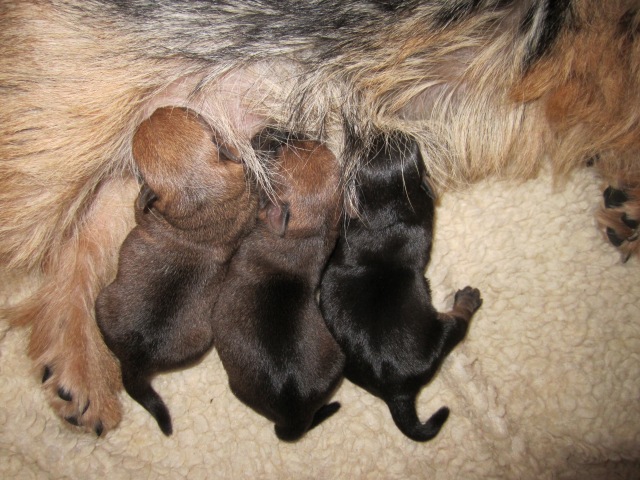I have been quiet on the blog front, while working feverishly on my upcoming book on nourishing a pregnant dog. Research for the book was a wild ride of reading through hundreds of scientific papers, from quite boring to those wake-up-you-have-to-hear-this type, uttered to my patient husband in the middle of the night.
These past few months alone I have shared the subject of placentophagy with about dozen people, so it is time to write about it.

The only thing a mama dog might want to eat on a whelp day, other than Mother’s Pudding, are placentas. As yuck as it sounds to us, placentophagy is common in mammals. Besides the obvious purpose of hiding any trace of birth and vulnerable newborns from predators, eating placenta has been proven to make birthing less painful, and to help with milk letdown. Research in rats, cows and pigs has shown that mothers which consumed afterbirth and amniotic fluid had elevated levels of natural opioid substances, e.g. endorphin and dynorphin, as compared to the mothers who were not allowed to consume placentas. The level of these endogenous (made within the body) opioids was considerably higher in mothers that ate afterbirth, which means that their pain threshold was dramatically increased. When you allow your bitch to eat the afterbirth, you allow her a powerful natural pain relief that was produced in her own body.
As for milk, placentophagy causes milk letdown because oxytocin contained in placenta allows smooth muscles around mammary glands to contract and release milk. Eating placentas may seem very strange to us, but it is actually very beneficial. I strongly urge you to save the placentas when the puppies are born via Cesarean and do not discard any from natural birth. Eating too many placentas can cause loose stools, so it is not a bad idea to save some, cut in smaller pieces, refrigerate and give them to the new mom over the period of the next 24 hours. The oxytocin content will cause milk letdown, and endorphins will help ease pain of the uterus contractions shrinking it for hours after birth. And very importantly, eating placentas also allows for the instinct of mothering to kick in.

Check this out. There was a study of dogs (Abitbol 1997)[i] that was looking at the role of amniotic fluid and afterbirth on mother-puppy bonding. This is actually mind boggling. The researchers studied 30 litters at birth and for 36 hours afterwards. They separated them into 3 groups. The puppies from the first group were taken from the dams as soon as they were born, their afterbirth discarded, and the pups were triple washed and returned to the moms. All mothers refused to accept the pups for the entire 36 hours of observation. In the second group they did the same: triple washed the pups right after birth, removed the placentas and returned the pups to the moms. All rejected! However, the scientists saved the placentas and after two and a half hours bathed the pups in saved amniotic fluid and rubbed placentas on them. The puppies were immediately accepted. In the third group the pups were removed for a single wash and returned to the mothers, along with their placentas. Those pups were all accepted immediately. To ease your worry I will add that the pups in the first group were eventually accepted but not for the first 36 hours.
 Earlier this year a bitch I bred sold to another breeder had a Cesarean delivery and was not accepting the puppies. I told my friend about this study of the role of placentas and amniotic fluid in mother-puppy bonding, but alas there were no placentas saved. So I asked to please rub the puppies in any discharge from the mother. It worked! If you find yourself in a similar situation, remember about the role of the afterbirth in puppy acceptance and bonding.
Earlier this year a bitch I bred sold to another breeder had a Cesarean delivery and was not accepting the puppies. I told my friend about this study of the role of placentas and amniotic fluid in mother-puppy bonding, but alas there were no placentas saved. So I asked to please rub the puppies in any discharge from the mother. It worked! If you find yourself in a similar situation, remember about the role of the afterbirth in puppy acceptance and bonding.
[i] Abitbol ML. 1997. Role of amniotic fluid in newborn acceptance and bonding in canines. J Matern Fetal Med. 1997 Jan-Feb;6(1):49-52.

Maybe Heather would like the other side to the placenta issue!
Debbie Garland Nopper perm reg’d http://www.nopperdogs.com
LikeLike
I’d love to hear.
LikeLike
Thanks — very interesting (more so than I, as a non breeder, expected!). Congratulations on the book, Magda. Your hard work will benefit many!
LikeLike
Thank you.
LikeLike
How many would be too many for her to eat at birth?
LikeLike
For little Norwiches I give one, two at the most, and then depending on how the whelping proceeds I might offer more. I certainly use up all within 24 hours. It’s amazing to see how the panting stops (pain management) after I give a little placenta hours after whelping.
LikeLike
Wonderful article!! I have always let the Dam’s consume some placentas but hate the loose stool… saving some is a great idea! Thanks !!
LikeLike
Very good info. I am glad to know that two is enough during whelp…..Cavalier King Charles Spaniel. I would never have known to save some for later consumption. Thanks so much.
LikeLike
Here! Here! I’ve been saying and practicing this for years.
LikeLike